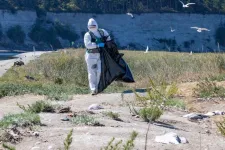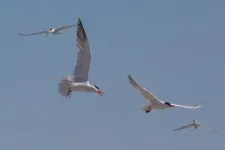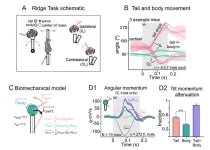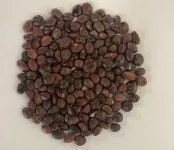(Press-News.org) PULLMAN, Wash. – An epidemiological study found that 56% of a large breeding colony of Caspian terns died from a 2023 outbreak of highly pathogenic avian influenza at Rat Island in Washington state. Since then, no birds have successfully bred on the island, raising concerns that the outbreak may have had a significant impact on an already declining Pacific-coast population.
As part of the study, a team including Washington Department of Fish and Wildlife (WDFW) as well as Washington State University researchers also documented that the avian flu virus H5N1was transmitted to harbor seals for the first time in the northeastern Pacific.
While there has not been another large coastal wildlife outbreak of H5N1 since, researchers estimated that about 10-14% of the Caspian tern population in the Pacific flyway have been lost to H5N1 infections.
“This Caspian tern event was the first big marine environment avian flu outbreak for Washington. It caused a significant, punctuated mortality for the Caspian terns, which were already a species in decline throughout this flyway,” said Katherine Haman, a wildlife veterinarian for WDFW and lead author on the study in the journal Frontiers in Veterinary Science.
Caspian terns are found across the country, and until a couple years ago, their largest breeding site was an island in the lower Columbia River, downstream from Portland. Because the birds were feasting on young, endangered salmon, they were discouraged from nesting on that island. It is likely that a portion of the extremely large Columbia River colony relocated to Rat Island near Fort Flagler Park in Jefferson County—then, came the avian flu in 2023.
Haman credited citizen volunteer docents from the Friends of Fort Flagler and local kayaking guides with noticing the first bird deaths on Rat Island early and alerting officials. This allowed researchers to respond early, collecting dead birds and euthanizing sick ones. A total of 1,101 adults and 520 chicks were killed by the outbreak.
The researchers also noted 15 dead harbor seals in the area which usually only sees 1 or 2 seal deaths a year. Through tissue samples, WSU researchers at the Washington Animal Disease Diagnostic Laboratory (WADDL) were able to first identify H5N1 in the birds, but the tests in seals were harder to confirm.
“We tend to think of avian influenza as a respiratory disease, but the seal respiratory samples were initially negative for H5N1. That seemed odd because there was a relatively high mortality in the seals, and there were also birds that were sick at the same time,” said co-author Kevin Snekvik, a WSU veterinary pathologist and WADDL executive director.
Further testing in other organs revealed that avian flu had a different pathology in the harbor seals causing an inflammatory response in their brains. The team performed a whole genome sequencing of the virus confirming that the seals likely contracted the virus from the terns.
Avian influenza has been killing many seals and sea lions in other parts of the world, particularly in South America, but so far that same spread has not yet occurred in the Pacific Northwest. The consequences for the terns in the region, however, has been more dire. There is no vaccine or treatment yet available in the U.S. for animals impacted by the avian flu. It is difficult to control in wildlife given the rapid spread and the difficulty associated with capture and handling of wild animals, so at this stage, researchers are trying to gain insights on the spread of the disease in wild populations by tracking the spread and understanding the impact.
Human cases of avian flu in Washington and elsewhere in the U.S. have occurred primarily in agricultural workers who were in close contact with infected domestic animals, according to the Centers for Disease Control and Prevention.
The researchers emphasized that people should not touch sick or dying wildlife, and instead report the animals on WDFW’s website.
This research received support from the Washington state legislature, Centers for Disease Control and Prevention, National Oceanic and Atmospheric Association, the Washington Department of Health, WDFW and WADDL. The study was made possible by a large collaboration including additional researchers from WSU and WDFW as well as Center Valley Animal Rescue, National Marine Fisheries Service, Pennsylvania State University, Washington Department of Health and University of California, Davis.
“The success of this study and the ongoing investigation is a result of a large number of organizations working together seamlessly. For wildlife investigations, it is absolutely paramount that we work across lines,” said co-author Tom Waltzek, a researcher with WADDL and WSU’s College of Veterinary Medicine.
END
Washington coast avian flu outbreak devastated Caspian terns, jumped to seals
2024-11-06
ELSE PRESS RELEASES FROM THIS DATE:
Mice tails whip up new insights into balance and neurodegenerative disease research
2024-11-06
Why do mice have tails?
The answer to this is not as simple as you might think. New research from the Okinawa Institute of Science and Technology (OIST) has shown that there’s more to the humble mouse tail than previously assumed. Using a novel experimental setup involving a tilting platform, high-speed videography and mathematical modelling, scientists have demonstrated how mice swing their tails like a whip to maintain balance – and these findings can help us better understand balance issues in humans, paving the way for spotting and treating neurodegenerative diseases like multiple ...
New study: Earthquake prediction techniques lend quick insight into strength, reliability of materials
2024-11-06
CHAMPAIGN, Ill. — Materials scientists can now use insight from a very common mineral and well-established earthquake and avalanche statistics to quantify how hostile environmental interactions may impact the degradation and failure of materials used for advanced solar panels, geological carbon sequestration and infrastructure such as buildings, roads and bridges.
The new study, led by the University of Illinois Urbana-Champaign in collaboration with Sandia National Laboratories and Bucknell University, shows that the amount ...
Vitamin D during pregnancy boosts children’s bone health even at age seven
2024-11-06
Vitamin D during pregnancy boosts children’s bone health even at age seven
Children whose mothers took extra vitamin D during pregnancy continue to have stronger bones at age seven, according to new research led by the University of Southampton and University Hospital Southampton (UHS).
Bone density scans revealed that children born to mothers who were given vitamin D supplements during pregnancy have greater bone mineral density in mid-childhood. Their bones contain more calcium and other minerals, making them stronger and less likely to break.
Researchers say the findings, published in The American Journal of Clinical Nutrition, reinforce the importance of ...
Use of “genetic scissors” carries risks
2024-11-06
The CRISPR molecular scissors have the potential to revolutionize the treatment of genetic diseases. This is because they can be used to correct specific defective sections of the genome. Unfortunately, however, there is a catch: under certain conditions, the repair can lead to new genetic defects – as in the case of chronic granulomatous disease. This was reported by a team of basic researchers and physicians from the clinical research program ImmuGene at the University of Zurich (UZH).
Chronic granulomatous disease is ...
Does work-related stress compromise cardiovascular health?
2024-11-06
In a large multi-ethnic group of adults in the United States without cardiovascular disease, those with work-related stress were more likely to have unfavorable measures of cardiovascular health. The findings are published in the Journal of the American Heart Association.
For the analysis, investigators assessed data collected between 2000 and 2002 for 3,579 community-based men and women aged 45–84 years enrolled in the Multi-Ethnic Study of Atherosclerosis. Cardiovascular health was determined based on seven metrics—smoking, physical activity, body mass index, diet, total cholesterol, blood pressure, and blood glucose—with each metric contributing zero points, ...
New research may lead to potatoes that are less reliant on nitrogen fertilizers
2024-11-06
Because nitrogen fertilizers contribute to global greenhouse gas emissions, scientists are looking for ways to modify agricultural plants so that they rely on less nitrogen. In research published in New Phytologist, investigators have found that blocking a particular protein may achieve this goal in potatoes.
The protein, called Solanum tuberosum CYCLING DOF FACTOR 1 (StCDF1), binds to DNA and plays a key role in regulating tuberization in potatoes. In this latest research, investigators found that StCDF1 ...
Do commercial ties influence ESG ratings?
2024-11-06
An analysis published in the Journal of Accounting Research uncovers evidence that conflicts of interest arising from commercial ties lead to bias in environmental, social, and governance (ESG) ratings.
Investigators focused on Moody’s and S&P’s acquisitions of ESG rating agencies Vigeo Eiris and RobecoSAM. Their analysis revealed that after these ESG rating agencies were acquired by Moody’s and S&P, they issued higher ratings to existing paying clients of Moody’s and S&P. Specifically, ...
Study assesses "gendered space" in financial institutions in Pakistan
2024-11-06
In Islamic cultures, purdah, which literally means “curtain,” is a practice that involves the seclusion of women from public observation and the enforcement of high standards of female modesty. Research published in the Journal of Management Studies examines the significance of purdah (spatial modesty) in gender relations in financial institutions in Pakistan.
The research was based on the lived experiences of women and men working in two banks based in Pakistan. One of the study’s co-authors, Shafaq Chaudhry, PhD, of the University of Central Lancashire, in the UK, sought internships for six weeks ...
Chinese herbal medicine’s potential in preventing dementia
2024-11-06
Attempts to discover a breakthrough dementia drug might be drawing attention these days, but traditional medicinal products can offer hints for preventive medicine.
A research group led by Specially Appointed Professor Takami Tomiyama of Osaka Metropolitan University’s Graduate School of Medicine has found that administering the dried seeds of a type of jujube called Ziziphus jujuba Miller var. spinosa, used as a medicinal herb in traditional Chinese medicine, holds promise in restoring cognitive and motor function in model mice.
By administering hot water extracts of Zizyphi spinosi semen to model mice with ...
Firms that read more perform better
2024-11-06
[Vienna, November 6, 2024] — “Tell me how you read and I’ll tell you who you are.” By analyzing online reading behavior across millions of firms worldwide, a new study out of the Complexity Science Hub (CSH) connects how much information companies consume and how the consumption relates to their size.
"The way companies consume information is reminiscent of biological organisms. They take in, transmit, and transform information to make decisions. As with organisms, there are important size differences. Larger firms tend to consume information more efficiently ...





